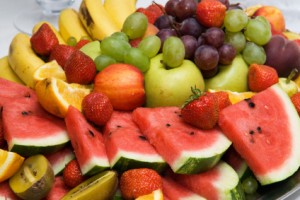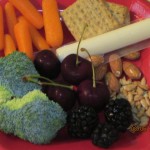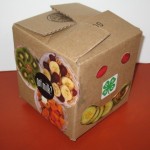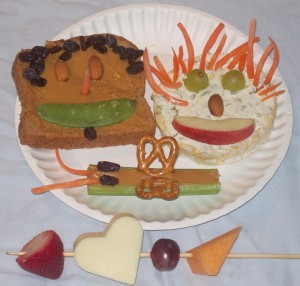by Angela Hinkle | Jul 2, 2013

Colorful vegetables contain phytochemicals to help reduce the risk of heart disease, type 2 diabetes, and high blood pressure.
Eat more vegetables for your health
Vegetables are a good source of vitamins, minerals, and fiber. When included as part of a well-balanced diet and a healthy active lifestyle, vegetables can help: lower your cholesterol, reduce obesity and maintain a healthy weight, and lower your blood pressure. Vegetables contain phytochemicals that help to lower risk of diseases like heart disease, type 2 diabetes, and high blood pressure.
What foods are in the vegetable group?
Any vegetable or 100% vegetable juice counts as being in the vegetable group. Vegetables can be raw or cooked; fresh, frozen, canned, or dried/dehydrated; and may be whole, cut-up, or mashed.
Based on their nutrient content, vegetables are organized into 5 subgroups*:
- Dark green like broccoli or spinach
- Starchy like corn or potatoes
- Red & orange like carrots or red peppers
- Peas & dried beans (these can also be the protein group) like black beans or kidney beans
- Other like green beans and onions
*For a more inclusive list, go to: http://www.choosemyplate.gov/food-groups/vegetables.html
Helpful tips to eat more veggies
- Make it easy. Pick up pre-washed bags of salad greens. Buy bagged baby carrots or celery sticks.
- Keep meals interesting – vary your veggie choices.
- Buy fresh vegetables in season. They cost less and are likely to taste their best.
- Stock up on frozen veggies for quick and easy cooking in the microwave.
- Try your vegetables crunchy, raw, or lightly steamed.
- For lunch, have a main dish salad (go easy on the salad dressing).
- Make a vegetable main dish like a soup or vegetable stir-fry. Then add foods from the other four food groups to complement it.
- Shred carrots or zucchini into meatloaf, casseroles, breads, muffins, and spaghetti sauce.
- Include more green salads with your lunches and dinners.
- For more flavor and nutrients, use pureed, cooked veggies like potatoes to thicken soups, stews, and gravies.
- Load the veggies onto pizzas and into omelets.
- Grilled vegetables like eggplant are terrific. Use mushrooms, green peppers, and onions to make kabobs.
Make veggies more enticing
- Color, color, color – orange carrots, purple shredded cabbage, red or green peppers, white cauliflower, yellow squash. How many colors can you add?
- Many vegetables taste great with a low-fat dip or dressing.
- Don’t forget to add those dried beans into salads, chili, and soups.
- Keep a see-through container of cut-up veggies up front in the refrigerator. When you open the door, those yummy, colorful vegetables are the first thing the whole family sees.
Veggie tips for kids
- Be the good example. Eat vegetables with all your meals and snacks.
- Let children choose vegetables while shopping and let them help prepare the veggies for the meal.
Vegetables on a budget
Plan meals around vegetables that go a long way. Include veggies you can grab for quick snacks or turn into casseroles and soups that you can eat a couple of times during the week. Buy extra vegetables when they are on sale. Then freeze the veggies or prepare a dish to be frozen for a busy night’s dinner. Prepare more vegetables than you need so you have leftovers. Try substituting half the meat in a recipe with beans or vegetables. This will reduce the fat, increase fiber, and save you money.
Super meals planned around vegetables
Stir-fried vegetables, pasta primavera, vegetable lasagna, vegetable chili, bean soup, and baked potatoes topped with broccoli and sprinkled with grated cheese.
So, what are you waiting for? Eat more – veggies.
by Angela Hinkle | May 28, 2013

Fruit – sweet, refreshing, and good for you!
As the days get warmer, bring on the cool refreshment of fruit. Now is the time to delight in fruit’s tasty, healthy goodness.
Reduce Risk and Protect
A healthy diet that is rich in fruits may reduce risk for heart disease, type 2 diabetes, and obesity, and may protect against certain types of cancers.
Healthy Nutrients
Nature brings most fruit to us low in fat, sodium, and calories, and always with zero cholesterol. Fruits are a great source of many essential nutrients and most of us don’t get enough. These include:
- Dietary fiber – helps to reduce blood cholesterol levels, is important for maintaining proper bowel function, helps reduce constipation, and provides a feeling of fullness without too many calories.
- Potassium – helps to maintain healthy blood pressure.
- Vitamin C – important for repairing all body tissues, healing cuts and wounds, and keeping teeth and gums healthy.
- Folate (folic acid) – helps the body form red blood cells and reduces the risk of neural tube defects during fetal development.
The USDA MyPlate recommends making half your plate fruits and vegetables. http://www.choosemyplate.gov
How Can You and Your Family Eat More Fruit?
- For snacks, wash whatever fruits you have on hand and place them in a big attractive bowl or basket on your table or desk. When you go by, you can grab one and start munching on it.
- Make fruit more fun and interesting by cutting it up and making it into a colorful fruit salad.
- Add fresh, frozen, or canned fruit to a smoothie or shake. Add fruit to drinks like tea and lemonade. Add some fruit to your water for a little kick of taste.
- Make a habit of using fruit as a plate garnish for breakfast, lunch, and dinner.
- Add a variety of fruit chunks to bamboo skewers or craft sticks for kabobs.
- Fruit added to yogurt provides more color, flavor, and nutrition.
- Since dried fruits last a long time, you can store a package in your car, desk, or even your pockets for a quick pick-me-up.
Sweet, refreshing, good for you fruit – now is the time to savor and enjoy.
For more information, contact your UF/IFAS county extension office.
by Angela Hinkle | Oct 23, 2012
 Those are familiar words for most of us with kids. Though they are not really starving, most children do need a little afternoon boost when they come home from school. It may have been hours since lunch and dinner won’t be ready for a while. A healthy snack is usually just the right answer.
Those are familiar words for most of us with kids. Though they are not really starving, most children do need a little afternoon boost when they come home from school. It may have been hours since lunch and dinner won’t be ready for a while. A healthy snack is usually just the right answer.
When planning afterschool snacks, think of them as the fourth meal of the day or as a mini-meal. Hopefully, you wouldn’t plan a dinner of just potato chips or candy, so why plan snacks that way? Use the food groups from MyPlate to help you plan healthy, ready-to-eat snacks from each food group.
- Fruit – Have a bowl of fruit on the counter always at the ready. Keep a pre-cut fruit salad or peeled oranges in the refrigerator. Make 100% fruit juice popsicles.
- Vegetables – Keep cut up veggies available in plastic zippered bags with kid-friendly dips like ranch dressing to go with them.
- Protein – A variety of nuts and seeds is always good to have on hand. Hard boiled eggs offer great protein power as well.
- Dairy – String cheese and yogurt cups are terrific dairy sources.
- Whole Grains – Whole grain crackers, popcorn, and granola mix add plenty of crunch.
 “Easy” and “available” are the key planning points to remember. Designate a snack area in the refrigerator or pantry. Decorate a personalized snack box for each child filled with favorite healthy snacks. A healthy variety of snacks always at the ready holds our child’s interest, provides the much needed energy to close the gap between lunch and dinner, provides nutrients they may not have gotten from other meals in the day, and keeps them from … well, starving.
“Easy” and “available” are the key planning points to remember. Designate a snack area in the refrigerator or pantry. Decorate a personalized snack box for each child filled with favorite healthy snacks. A healthy variety of snacks always at the ready holds our child’s interest, provides the much needed energy to close the gap between lunch and dinner, provides nutrients they may not have gotten from other meals in the day, and keeps them from … well, starving.
by Angela Hinkle | Jun 1, 2012
School’s out! One way to get creative with all this extra time and to eat nutritiously is to make and eat healthy snacks. Like an arts and crafts project, making a snack can be a great summertime activity. Bonus: the kids get to eat their artwork and you get to sneak nutritious foods into their day for a healthy diet.
Some works of art need the following elements:
- Foundation – slices of whole wheat bread, tortillas, English muffins, lettuce leaves, rice cakes, zucchini or cucumber rounds, apple or pineapple slices.
- Glue – peanut butter, low-fat cream cheese, cheese spread, hummus, refried beans, low-fat yogurt, jam, pizza sauce, or low-fat ranch dressing.
- Bling – seeds, nuts, grapes, raisins, match stick carrots, olives, beans, low-fat granola, diced fruits and veggies.
Start from the foundation and work up to the bling. Create faces, animals, or landscapes. Let the plate be your canvas. It’s a great way to try a new food or sample a food prepared in a totally different way.
For other works of art, use toothpicks, skewers, popsicle sticks, or edible pretzel rods to make shish kabobs. Cut out cheese shapes with small cookie cutters and add to the stick alternating with cut-up fruits and vegetables. Make a beautiful edible bouquet.
Kids also are more likely to enjoy new foods if they are served in fun containers. Try using mugs, champagne glasses, ice cream cones, or party hats.
Be sure to include nutritious foods from all the food groups as your artists create throughout the summer: load up on fruits and vegetables, incorporate whole grains, and go lean on the dairy and protein.
No sitting around loading up on unhealthy “junk” foods out of boredom this summer. The time for healthy edible snack art is now.





